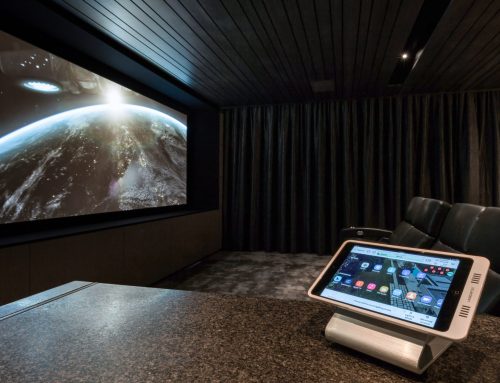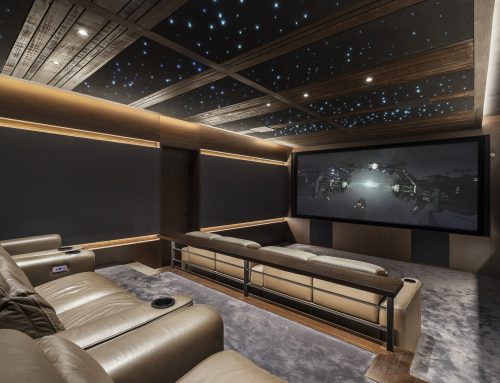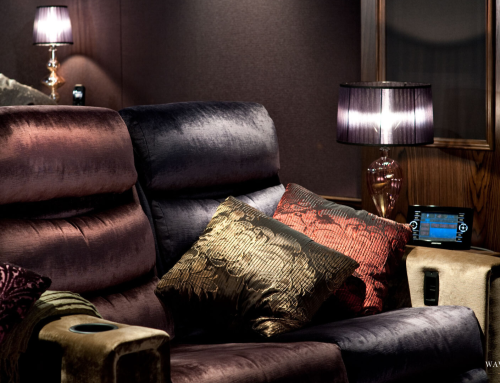This process typically entails insulating walls, sealing gaps, and installing acoustic panels. Additionally, fine-tuning audio settings, such as strategic speaker placement and utilization of features like Dynamic EQ or Dynamic Volume, significantly contributes to the overall sound quality.
Familiarity with room acoustics, including the influence of room dimensions and volume on sound behavior, is critical. Addressing common acoustic issues, like excessive reverberation, uneven frequency response, and standing waves, can lead to sound quality enhancement. Exploiting materials such as acoustic foam or fiberglass insulation for sound absorption can prove beneficial.
In sum, the mastery of room acoustics and audio settings adjustment is key to achieving an immersive home theatre experience.[/vc_column_text][/vc_column][/vc_row][vc_row][vc_column][vc_empty_space alter_height=”medium” hide_on_mobile=””][vc_column_text]
Understanding Echo and Reverberation
[/vc_column_text][vc_empty_space hide_on_mobile=””][vc_column_text]Understanding echo and reverberation is a key aspect of enhancing room acoustics, as these factors can significantly affect sound quality in a home theatre setting.Echo and reverberation result from sound waves bouncing off surfaces such as walls, ceilings, and floors, leading to a prolonged sound. This can hinder the audio experience by creating an imbalance in sound clarity and balance.
Reducing sound reflections is therefore paramount for optimizing room acoustics. This can be achieved by incorporating soft materials like curtains, carpets, or upholstered furniture, or installing acoustic panels on walls or ceilings.
Additionally, optimizing speaker placement can significantly reduce these effects, as it allows for a more direct sound path, minimizing reflections.
Consequently, managing echo and reverberation is critical for maximizing the home theatre experience.[/vc_column_text][vc_empty_space hide_on_mobile=””][vc_single_image image=”5367″ img_size=”full”][/vc_column][/vc_row][vc_row][vc_column][vc_empty_space alter_height=”medium” hide_on_mobile=””][vc_column_text]
Soundproofing Essentials
[/vc_column_text][vc_empty_space hide_on_mobile=””][vc_column_text]Soundproofing is a crucial element that significantly enhances the audio quality of a home entertainment system by preventing sound leakage and eliminating background noise. The selection of soundproofing materials plays a pivotal role in achieving optimal room acoustics. Materials such as insulation, acoustic panels, and sealants are commonly used. These materials absorb sound waves, reducing echoing and reverberation.The benefits of soundproofing extend beyond just improved audio quality. It prevents disturbing others in the vicinity and creates a more immersive entertainment experience. The following table summarizes the different soundproofing materials and their benefits:[/vc_column_text][vc_empty_space hide_on_mobile=””][trx_sc_table type=”default” align=”center” width=”100%” title_style=”default” title_align=”left” title=”” subtitle=”” description=”” link=”” link_text=”” link_image=”” id=”” class=”” css=””]
| Soundproofing Material | Benefits |
|---|---|
| Insulation | Absorbs sound waves and reduces echo |
| Acoustic Panels | Absorbs sound and reduces reverberation |
| Sealants | Seals gaps to prevent sound leakage |
Fine-Tuning Audio Settings
[/vc_column_text][vc_empty_space hide_on_mobile=””][vc_column_text]Optimal audio performance in a home entertainment system necessitates meticulous fine-tuning of audio settings. One of the significant aspects of this process includes receiver calibration, which ensures accurate speaker levels and distances. Furthermore, optimizing speaker placement is paramount to enhance sound quality.Key steps in fine-tuning audio settings include:[/vc_column_text][vc_column_text]
- Utilizing receiver or amplifier calibration tools to adjust speaker levels and distances.
- Positioning speakers strategically to avoid potential obstacles that cause sound reflection or absorption.
- Enabling automatic features such as Dynamic EQ or Dynamic Volume to maintain tonal balance and volume adjustments.
- Selecting a suitable surround sound mode to create immersive listening experiences.
- Considering room acoustics when making adjustments to ensure balanced sound reproduction.
Addressing Common Acoustic Issues
[/vc_column_text][vc_empty_space hide_on_mobile=””][vc_column_text]Addressing common acoustic issues such as excessive reverberation, uneven frequency response, and standing waves significantly enhances the overall sound quality in a home entertainment system. These issues, stemming largely from the impact of room dimensions and the nature of the room’s surfaces, can be mitigated through the use of sound absorption materials and appropriate room design.[/vc_column_text][vc_empty_space alter_height=”medium” hide_on_mobile=””][trx_sc_table type=”default” align=”none” width=”100%” title_style=”default” title_align=”default” title=”” subtitle=”” description=”” link=”” link_text=”” link_image=”” id=”” class=”” css=””]| Acoustic Issue | Cause | Solution |
|---|---|---|
| Excessive Reverberation | Hard, reflective surfaces | Use of sound absorption materials such as acoustic foam, curtains, or carpets |
| Uneven Frequency Response | Poor speaker placement, room shape | Strategic speaker placement, use of diffusers or bass traps |
| Standing Waves | Parallel walls, especially in smaller rooms | Use of diffusers, bass traps, or altered wall construction |






